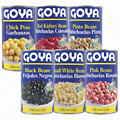
While Goya has emerged as a global business and a category leader, in 2009, executives recognized the company was still holding onto a small business mind set-and associated supply chain processes-that would limit its growth. Many processes remained manual when they could be automated. In addition, Goya’s supply chain model and associated systems were based on a transactional approach that focused on inventory purchases instead of consumer demand and an integrated forecasting process.
Goya turned to JDA Software for support in adding new, technology-driven supply chain capabilities to its proven business model. Goya chose JDA’s solutions for demand management, fulfillment and order optimization to modernize its global supply chain.
“We’ve built our company on maximizing our sales by neighborhood, and that approach has worked very well since 1936,” says Peter Unanue, Goya executive vice president of operations and logistics. “But as Goya has expanded, [our] targeted sales strategy has added incredible diversity to our product line. In just the last five years, the number of SKUs that we carry has grown by 60 percent. That diversity gives us a significant competitive advantage, but it also has added a lot of supply chain complexity.”
JDA’s solutions for demand management and classification helped Goya focus on anticipating consumer needs across its hundreds of SKUs and local markets, allowing inventory decisions to be targeted to actual shopper demand. Because of its enormous product diversity and lack of an integrated demand planning process, the processor was enduring 5 to 6 percent out-of-stock levels, when executives expected 2 percent.
JDA and Goya partnered to create an integrated forecasting and planning process that consolidates demand across all locations and business segments to arrive at a one-number forecast that drives every inventory and replenishment decision, and is based on seasonal volatility, promotions and other factors.
“Twice a year, we use JDA Demand Classification to develop highly targeted forecasts that recognize the unique demand factors underlying different SKUs. The solution defines the best-fitting demand algorithms for each product. That enables us to have a much more accurate view of future demand, taking into account both promotions and product seasonality,” says Unanue.
As a result, Goya has reduced its out-of-stock rates to 2 percent without increasing inventory levels. “I think the results we have achieved have differentiated us from our competition in that we are able to provide much better service. If a customer needs certain products, we’re able to deliver more than 98 percent of the time.”
Goya has achieved a range of other business benefits. “Because we are consolidating demand, today, we can leverage bulk-buying strategies that keep costs down on the supply side,” says Unanue. “And, because we have consolidated our view of our inventory, whether it is in a warehouse in
For products Goya sources directly from worldwide vendors, the JDA Order Optimization module generates orders automatically based on the demand forecast and current inventory levels. It also cuts the time of creating a new individual purchase order from 20-30 minutes to one to three minutes. By automating the process, buyer planning productivity has improved by 700 percent.
Unanue reports other benefits:
- For Goya’s buyers, generating an order has become more of a review and approval process, as opposed to creating each individual purchase order from scratch.
- Goya has realized significant transportation savings. The right products are at the right place at the right time. Orders are sized to use the entire capability of trucks.
- The JDA solutions are highly configurable, both in their functionality and user interfaces.
- Goya expects to plan the entire supply chain on a single-number forecast.

